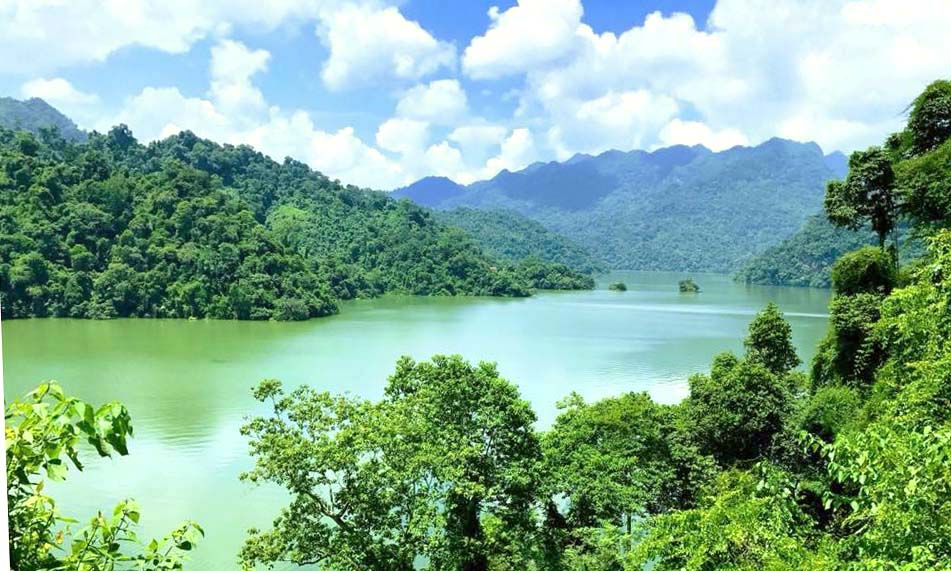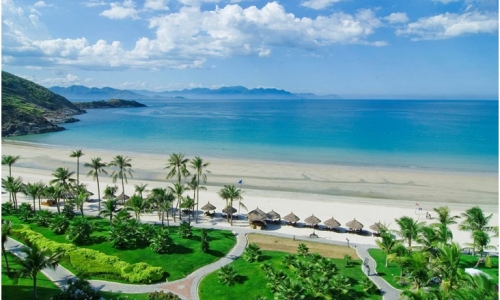Top experience you may interested in:
- Hue to Hoi An motorbike tour via Hai Van pass
- Hue to Hoi An motorbike rental
- Hoi An to Hue motorbike rental
Travel Experience to Ba Be Lake, Bac Kan (2023)
 Where is Ba Be Lake?
Where is Ba Be Lake?
Ba Be Lake, ranked as one of the 20 most beautiful freshwater lakes in the world by UNESCO, is a famous destination that attracts thousands of tourists every year. Located approximately 230 km north of Hanoi, Ba Be Lake is situated in Nam Mau Commune, Ba Be District, Bac Kan Province. The lake was formed through geological processes around 200 million years ago in Southeast Asia. Local people in Bac Kan refer to Ba Be Lake as the “green heart” of Ba Be National Park, as it plays a vital role in regulating water for the surrounding areas.
Sitting at an altitude of around 150 meters above sea level, Ba Be Lake has a depth of about 20 meters, with its deepest point reaching 35 meters and containing approximately 9 million cubic meters of water. It is surrounded by majestic rocky mountains and vast tropical forests. Its unique geological and hydrological structure makes it especially remarkable, but its most extraordinary feature is that the lake has never dried up.
What to visit in Ba Ba lake
Throughout the four seasons, Ba Be Lake remains pure, cool, and enchanting in its own way. Tourists can choose to visit Ba Be Lake at any time of the year according to their schedules. However, the most popular time for tourists to visit is during the summer when the scorching heat of the capital makes people seek a cooler and more comfortable climate. Additionally, early autumn or spring are also captivating times to visit. During these periods, the sky is higher and bluer, reflecting on the deep blue surface of the lake, accompanied by gentle breezes. Visitors can stroll around the lake, admire the majestic mountain scenery, and capture unforgettable moments in one of the most beautiful lakes in the world.
There are many other beautiful attractions around Ba Be Lake, such as An Ma Temple, Ba Goa Island, and Fairy Pond. Ba Goa Island is a small, peaceful island in the middle of the lake, resembling a tiny garden floating on the water, with a serene and quiet atmosphere that has remained unchanged over the years. Legend has it that the island was formed from a tale about two widowed women who bravely saved the entire village from a natural disaster with only two grains of rice given by a sacred dragon. In honor of their significant contributions, the island (the home of the widowed woman) was named “Ba Goa Island.” Apart from this, tourists can explore other attractions in Ba Be National Park, such as Puong Cave, Dau Dang Waterfall, Hua Ma Cave, and discover the “Hunt for Clouds on Hoa Mountain” post at Don Den.
When it comes to the beautiful scenery of Bac Kan, one cannot miss Ba Be National Park – an attractive and ideal eco-tourism destination for nature lovers. This place is recognized as an ASEAN Heritage Garden with a diverse and rich ecosystem. According to records, there are 322 bird species residing in the forests, 106 fish species living in Ba Be Lake, alongside 533 insect species, 1281 plant species (including about 182 orchid species), and 81 animal species, of which 66 species are listed in the World Red Book. This is indeed an impressive number, isn’t it?
Traveling to Ba Be National Park, tourists have the opportunity to immerse themselves in the pristine blue water, listen to the vibrant sounds of the wild and indulge in the majestic and poetic mountain and forest scenery.
Nang Tien Cave
Nang Tien Cave is a national cultural heritage associated with the legend of seven beautiful fairies. One beautiful day, all seven fairies decided to come down to the mortal world for sightseeing and were so engrossed in their fairy bath that they forgot about the time. By then, the heavenly gate had closed, forcing the fairies to take refuge in the human world. In pity, the gods created a cave for them to spend the night. From then on, people called it “Nang Tien Cave” (Fairy Cave).
Nang Tien Cave lies deep within the mountain, about 60 meters below the surface, adorned with countless natural limestone blocks, creating a splendid and resplendent interior. The cave has small niches that allow light and air to enter, making it feel spacious and refreshing for visitors exploring the cave. Around the cave, there are numerous eateries serving delicious Bac Kan specialties, such as roasted Bac Kan pig and Côn Minh noodles.
Another outstanding destination not to be missed is Puong Cave, a small cave about 5 km from Cho Ra town. The cave lies right next to the Nang River, flowing gracefully year-round. Occasionally, there are sections where the river water flows into the mountain crevices, creating small hollow caves with unique flowing water patterns, no less fascinating than the Bat Cave in Soc Trang.
Dau Dang Waterfall is a waterfall located on the gentle Nang River, stretching about 2 km, within the Ba Be National Park complex. Situated between two large rocky mountain ranges and blocked by large and small stones, the water falls from a height of up to 500 meters directly onto the river’s surface, creating a stunning and white curtain of water.
Moreover, below the waterfall is the habitat of an extremely rare and valuable fish species named “Ca Chien” (Big-Headed Carp). This fish species has a large and strong body, with some individuals weighing over 10 kg.
Private Transportation
To travel the long distance of about 150 km from Hanoi to Bac Kan by motorcycle or private car, tourists can choose the route via National Highway 3 through Thai Nguyen. In the past, reaching Bac Kan required traversing a small, narrow road that could take more than 5 hours to reach. However, with the completion of the new Hanoi – Thai Nguyen – Cho Moi expressway, the travel time has been reduced to around 2 hours. This allows tourists to spend more time exploring the beautiful landscapes of Bac Kan rather than spending half a day on transportation.
Public Transportation
From My Dinh Bus Station in Hanoi, you can easily catch a high-quality passenger bus to Bac Kan at a reasonable price. You can choose the routes heading to Cao Bang as these buses often pass through famous destinations in Bac Kan as well.
For tourists from other provinces and cities, it is advisable to travel to Hanoi first and then choose from various transportation options to reach Bac Kan.
A more relaxed and carefree option is to join a tour to Ba Be Lake. With an expense of approximately 2 million VND, you will be provided with transportation (depending on the number of participants), accommodation, main meals, entrance tickets to various attractions, and, most importantly, a tour guide who will accompany you throughout the journey, providing explanations to help you understand and appreciate this land even more. Since the distance from Hanoi to Bac Kan is not too far, tourists often decide to travel spontaneously. Whether for a weekend trip or a midweek escape, you can easily book a tour. A weekend trip lasting 3 days and 2 nights is quite sufficient to explore and “de-stress” in this tranquil land.
When to Travel to Ba Be Lake?
Bac Kan has a distinct climate division: the rainy season lasts from May to October, while the dry season starts from November to April of the following year.
Tourists who want to avoid the scorching heat and hustle and bustle of the city and immerse themselves in the refreshing and cool atmosphere of the mountains and forests often visit Ba Be Lake from May to September.
In spring, around Tet (Lunar New Year), the area comes alive with local festivals. In particular, from the 9th to the 11th day of the first lunar month every year, travelers from all over the country flock to Nam Mau Commune to participate in the Tống Tống Ba Be Festival. Although the Tày and Nùng ethnic groups in other places such as Ha Giang and Cao Bang also organize similar festivals, each place has its own unique characteristics. The Lồng Tồng Festival in Bac Kan is the largest and most distinctive traditional festival in the province, included in the list of intangible cultural heritage at the national level.
January is also the time when the villagers take a break after finishing their harvest, so tourists visiting Ba Be Lake will have the opportunity to share joy with the locals living here. The festival becomes even more exciting with cultural exchange performances by different ethnic groups, such as the melodious melodies of Tày music and the cheerful dances of the Mông ethnic group, along with countless fascinating folk games, such as throwing con (fabric ball), ca keo (pig chasing), thuyen dua (boat racing), and bit mat bat de (blindfolded goat catching).
Ba Be Lake has clean and abundant water sources, leading to the existence of numerous fish species. The majority of fish in the lake have firm, white, and sweet-flavored flesh. Locals often set up nets to catch fish early in the morning to prepare for the morning market. One particular dish is the “Cá Nướng Pắc Ngòi” (Pắc Ngòi Grilled Fish), caught mainly from Ba Be Lake. However, only small-sized fish about the size of a thumb are chosen.
Cá Nướng Pắc Ngòi requires a meticulous and time-consuming preparation process. After cleaning and gutting the fish, they are placed in a mesh bag and steamed until fully cooked. Then, around ten fish are placed on a long skewer and sun-dried for about 3-4 days until ready to be grilled. When eating, you only need to remove the fish from the skewer and grill them again using alcohol or charcoal fire. To maintain the tenderness and avoid bitterness, the fish should be lightly grilled until just cooked.
In summary, Ba Be Lake in Bac Kan is a captivating destination where tourists can immerse themselves in the beauty of nature, explore the cultural heritage, and indulge in the flavors of local delicacies. Whether you prefer private or public transportation, or joining a guided tour, the journey to Ba Be Lake will be rewarding and memorable. With its distinct charm in different seasons, Ba Be Lake awaits travelers with its enchanting allure all year round.
Popular tourist attractions
– What to visit in Mai Chau
– What to Visit in Moc Chau
– What to visit in Lai Chau




